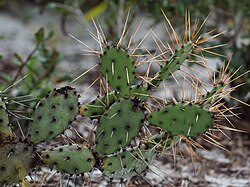Biology:Opuntia austrina
| Opuntia austrina | |
|---|---|

| |
| In Lake June-in-Winter Scrub State Park, Lake Placid, Florida | |
| Scientific classification | |
| Kingdom: | Plantae |
| Clade: | Tracheophytes |
| Clade: | Angiosperms |
| Clade: | Eudicots |
| Order: | Caryophyllales |
| Family: | Cactaceae |
| Genus: | Opuntia |
| Species: | O. austrina
|
| Binomial name | |
| Opuntia austrina Small
| |

| |
Range[1]
| |
| Synonyms | |
| |
Opuntia austrina, also known as the Florida prickly pear (with other common names such as the devils-tongue and hammock prickly pear), is a prickly pear cactus species that is endemic to Florida in the United States.
Description
Opuntia austrina has joints (also known as cladodes[2] and pads[3]), which are the segments that grow from the single, cylindrical stem,[4] that are elongated with the length most of the time 2 to 3 times the width.[5] The joints are often dark green in color.[2] Just like other cactus species, O. austrina has spines on the joints and on the stem. O. austrina can grow up to 1 m (3 ft 3 in) in height,[6] which will form large shrubs but can also form small treelets.[4] This cactus' plants are flowering, with yellow flowers that produce red fruits.[3]
Habitat
This species of prickly pear is mostly found in South Florida,[6] in sandy substrates often in brushy dunes inland and mangrove edges on the coast.[5] Other native habitats include scrub, scrubby flatwoods, and xeric, or dry, disturbed areas.[3] The yellow flowers of this cactus attracts many pollinators in this ecosystem like bees and other insects including the dotted skipper.[3]
Conservation
This cactus species is considered to be endemic to Florida,[3] but has been also recorded in other states.[7] This species is listed as Least Concern by the IUCN Red List.[1] However, a potential threat is one found in all members of the genus Opuntia – the cactus moth (Cactoblastis cactorum),[3] an invasive species that arrived to Florida in 1989 and has been a serious threat to the cacti in this genus all over North America.[3]
References
- ↑ 1.0 1.1 1.2 Majure, L.; Griffith, P. (2017). "Opuntia austrina". IUCN Red List of Threatened Species 2017: e.T199642A121620558. doi:10.2305/IUCN.UK.2017-3.RLTS.T199642A121620558.en. https://www.iucnredlist.org/species/199642/121620558.
- ↑ 2.0 2.1 Majure, L.; Judd, W.; Soltis, P.; Soltis, D. (2012). "Cytogeography of the humifusa clade of Opuntia S.S. Mill. 1754 (Cactaceae, Opuntioideae, Opuntieae): Correlations with pleistocene refugia and morphological traits in a polyploid complex". Comparative Cytogenetics 6 (1): 53–77. doi:10.3897/compcytogen.v6i1.2523. PMID 24260652.
- ↑ 3.0 3.1 3.2 3.3 3.4 3.5 3.6 "Opuntia austrina". https://www.fnps.org/plant/opuntia-austrina/.
- ↑ 4.0 4.1 Majure, L. C.; Soltis, D. E.; Soltis, P. S.; Judd, W. S. (2013). "A case of mistaken identity, Opuntia abjecta, long-lost in synonymy under the Caribbean species, O. triacantha, and a reassessment of the enigmatic O. cubensis.". Brittonia 66 (2): 118–130. doi:10.1007/s12228-013-9307-z.
- ↑ 5.0 5.1 Ward, D. (2009). "KEYS TO THE FLORA OF FLORIDA: 23, OPUNTIA (CACTACEAE)". Phytologia 91 (3): 383–393. https://www.phytologia.org/uploads/2/3/4/2/23422706/913383-393wardopuntia.pdf.
- ↑ 6.0 6.1 Majure, L. C. (2010). "Towards an evolutionary understanding of the Opuntia humifusa complex of North America". Cactus and Succulent Journal 82 (4): 156–163. doi:10.2985/015.082.0404.
- ↑ "Opuntia austrina". https://www.inaturalist.org/taxa/441411-Opuntia-austrina/.
Wikidata ☰ {{{from}}} entry
 |


